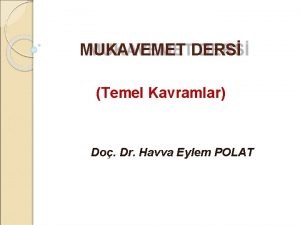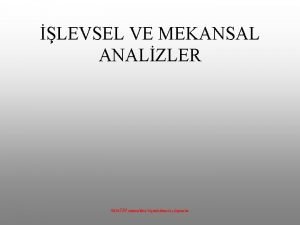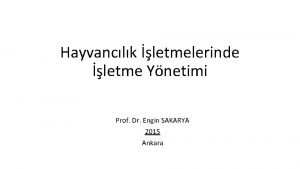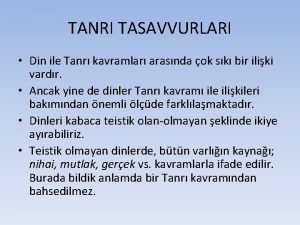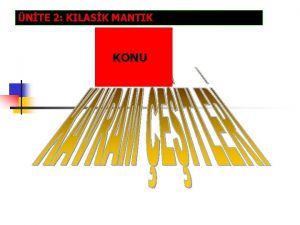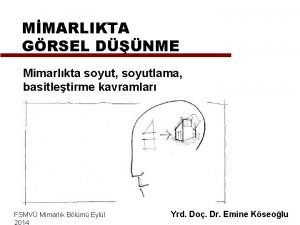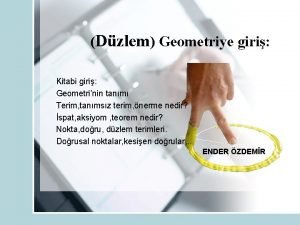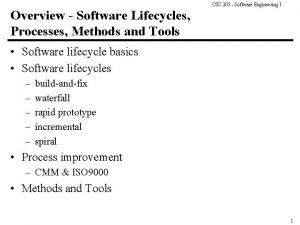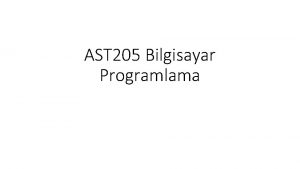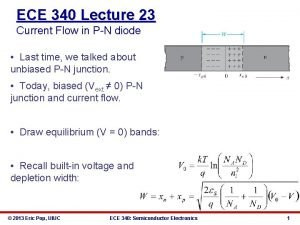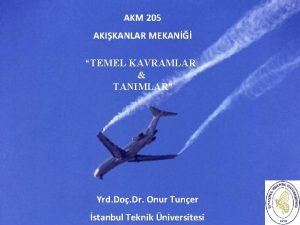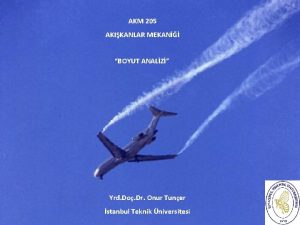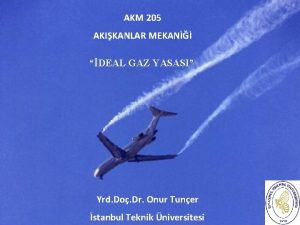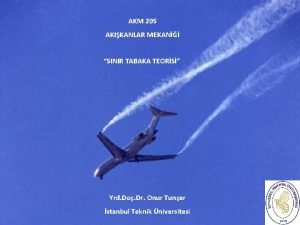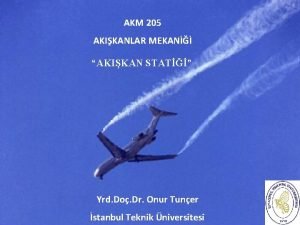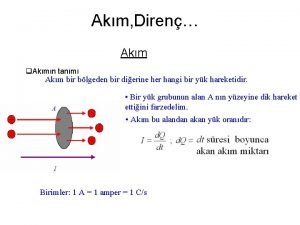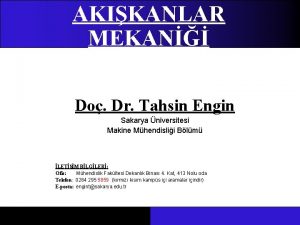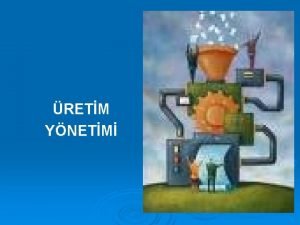AKM 205 AKIKANLAR MEKAN TEMEL KAVRAMLAR TANIMLAR Yrd



































- Slides: 35

AKM 205 AKIŞKANLAR MEKANİĞİ “TEMEL KAVRAMLAR & TANIMLAR” Yrd. Doç. Dr. Onur Tunçer İstanbul Teknik Üniversitesi

Introduction to Fluid Mechanics • Fluid Mechanics is concerned with the behavior of fluids at rest and in motion • Distinction between solids and fluids: – According to our experience: A solid is “hard” and not easily deformed. A fluid is “soft” and deforms easily. – Fluid is a substance that alters its shape in response to any force however small, that tends to flow or to conform to the outline of its container, and that includes gases and liquids and mixtures of solids and liquids capable of flow. – A fluid is defined as a substance that deforms continuously when acted on by a shearing stress of any magnitude.

Flow • Continuous deformation • Change of velocity of particles with respect to location • If all particles move with the same velocity, there is no flow (example: translation or rotation) Movement but not flow! water From our point of view these are related to fluid statics!

Some applications of fluid mechanics 1. Hydraulics: the flow of water in rivers, pipes, canals, pumps, turbines. 2. Aerodynamics: the flow of air around airplanes, rockets, projectiles. 3. Meteorology: the flow of the atmosphere. 4. Particle dynamics: the flow of fluids around particles, the interaction of particles and fluids (i. e. , dust settling, slurries, pneumatic transport, fluidized beds, air pollutant particles, corpuscles in our blood). 5. Hydrology: the flow of water and water-borne pollutants in the ground. 6. Reservoir engineering: the flow of oil, gas, and water in petroleum reservoirs. 7. Multiphase flow: coffee percolators, oil wells, carburators, fuel injectors, combustion chambers, sprays. 8. Combinations of fluid flow: with chemical reactions in combustion, with electromagnetic phenomena in magnetohydrodynamics, with mass transport in distillation or drying. 9. Viscosity-dominated flows: lubrication, injection molding, wire coating, lava, and continental drift.

BASIC IDEAS IN FLUID MECHANICS 1. The principle of the conservation of mass. 2. The first law of thermodynamics (the principle of the conservation of energy). 3. The second law of thermodynamics. 4. Newton’s second law of motion, which may be summarized in the form F = ma. Each of these four ideas is a generalization of experimental data. None of them can be deduced from the others or from any other prior principle. Rather, they stand on their ability to predict correctly the results of any experiment ever run to test them.

Methods of Analysis • System (or “Closed System”) ü Control Volume (or “Open System”)

Dimensions and Units In fluid mechanics we must describe various fluid characteristics in terms of certain basic quantities such as length, time and mass • A dimension is the measure by which a physical variable is expressed qualitatively, i. e. length is a dimension associated with distance, width, height, displacement. Ø Basic dimensions: Length, L (or primary quantities) Time, T Mass, M Temperature, Q Ø We can derive any secondary quantity from the primary quantities i. e. Force = (mass) x (acceleration) : F = M L T-2 • A unit is a particular way of attaching a number to the qualitative dimension: Systems of units can vary from country to country, but dimensions do not

Dimensions and Units Primary Dimension SI Unit British Gravitational (BG) Unit English Engineering (EE) Unit Mass [M] Kilogram (kg) Slug Pound-mass (lbm) Length [L] Meter (m) Foot (ft) Time [T] Second (s) Temperature [Q] Kelvin (K) Rankine (°R) Force [F] Newton (1 N=1 kg. m/s 2) Pound (lb) Pound-force (lbf) Conversion factors are available in the textbook inside of front cover.

Units of Force: Newton’s Law F=m. g • SI system: Base dimensions are Length, Time, Mass, Temperature Ø A Newton is the force which when applied to a mass of 1 kg produces an acceleration of 1 m/s 2. Ø Newton is a derived unit: 1 N = (1 Kg). (1 m/s 2) • BG system: Base dimensions are Length, Force, Time, Temperature Ø A slug is the mass which produces an acceleration of 1 ft/s 2 when a force of 1 lb is applied on it: Ø Slug is a derived unit: 1 slug=(1 lb) (s 2)/(ft) • EE system: Base dimensions are Length, Time, Mass, Force and Temperature Ø The pound-force (lbf) is defined as the force which accelerates 1 pound-mass (lbm), 32. 174 ft/s 2.

Units of Force – EE system To make Newton’s law dimensionally consistent we must include a dimensional proportionality constant: where

Example: Newton’s Law • An astronaut weighs 730 N in Houston, TX, where the local acceleration of gravity is g=9. 792 m/s 2. What is the mass of the astronaut? What is his weight on the moon, where g=1. 67 m/s 2? • Redo the same problem in EE units. In EE units the astronaut weighs 164. 1 lbf, g. Houston=32. 13 ft/s 2 and gmoon=5. 48 ft/s 2.

Dimensional Homogeneity • All theoretically derived equations are dimensionally homogeneous: dimensions of the left side of the equation must be the same as those on the right side. – Some empirical formulas used in engineering practice are not dimensionally homogeneous • All equations must use consistent units: each term must have the same units. Answers will be incorrect if the units in the equation are not consistent. Always chose the system of units prior to solving the problem

Properties of Fluids Ø Fundamental approach: Study the behavior of individual molecules when trying to describe the behavior of fluids Ø Engineering approach: Characterization of the behavior by considering the average, or macroscopic, value of the quantity of interest, where the average is evaluated over a small volume containing a large number of molecules Treat the fluid as a CONTINUUM: Assume that all the fluid characteristics vary continuously throughout the fluid

Measures of Fluid Mass and Weight • Density of a fluid, r (rho), is the amount of mass per unit volume of a substance: r=m/V – For liquids, weak function of temperature and pressure – For gases: strong function of T and P from ideal gas law: r = P M/R T where R = universal gas constant, M=mol. weight R= 8. 314 J/(g-mole K)=0. 08314 (liter bar)/(g-mole K)= 0. 08206 (liter atm)/(g-mole K)=1. 987 (cal)/(g-mole K)= 10. 73 (psia ft 3)/(lb-mole °R)=0. 7302 (atm ft 3)/(lb-mole °R) (1. 1)

Fluid as a Continuum

Fluid as a Continuum

Velocity Field

Velocity Field Consider also • Steady and Unsteady Flows • 1 D, 2 D, and 3 D Flows • Timelines, Pathlines, and Streaklines

Stress Field

Density

Measures of Fluid Mass and Weight • Specific volume: u=1/r • Specific weight is the amount of weight per unit volume of a substance: g=w/V=rg • Specific Gravity (independent of system of units)

Description & Classification of Fluid Motions • • Viscous and Inviscid Flows Laminar and Turbulent Flows Compressible and Incompressible Flows Internal and External Flows Internal Flows – Flows completely bounded by solid surfaces. Examples: Flow in ducts and vessels; flow in pumps, fans, and compressors. – Open-channel flow The internal flow of liquids in which the ducts does not flow full. Examples: Flow in rivers, irrigation ditches, and aqueducts. External Flows – Flow over bodies immersed in an unbounded fluid. Examples: Flow over a submerged submarine, flow over an airplane, and flow over a gulf ball, etc.

Fluid types: Gas vs Liquid If the fluid is a gas: it will expand readily, filling all the space vacated by the piston; gases can expand without limit to occupy space made available to them. If the fluid is a liquid: as the piston is raised, the liquid can expand only a small amount, and then it can expand no more. What fills the space between the piston and the liquid? Part of the liquid must turn into a gas by boiling, and this gas expands to fill the vacant space. (When the molecules separate more than this distance, they cease behaving as a liquid and behave as a gas) Because of their closer molecular spacing, liquids normally have higher densities, viscosities, refractive indices, etc. , than gases. This frequently leads to quite different behaviors of liquids and gases.

Specific gravity

Viscosity (resistance to flow) Shear stress

Newtonian vs non-Newtonian rheology


Units of viscosity • The viscosity is the slope of the line of shear stress versus shear rate so its SI unit is 1 Pa / (1/s) = 1 Pa · s • The customary unit of viscosity is the poise , however it is too large a unit for most common fluids. • By sheer coincidence the viscosity of pure water at about is 0. 01 poise; for that reason the common unit of viscosity in the US is the centipoise.

Kinematic viscosity Exercise: What is the kinematic viscosity of air in strict SI ?

Surface tension

Surface Tension

Surface Tension Units 1 N/m = 1 kg / s 2 (lbf/in) dyne/cm 1 dyne/cm = 0. 001 N/m

Pressure: compressive force divided by area Ordinary fluids cannot permanently resist shear forces, so the water begins to flow and finally flows away. If we really wanted to squeeze the water, we would put it in some container that would prevent its flowing out to the side. The pressure at a point in a fluid at rest is the same in all directions. The usual definition of pressure in a solid is as follows: Pressure at a point is the average of the compressive stresses measured in three perpendicular directions.

Absolute and gauge pressure -7. 25 psig

Summary 1. Fluid mechanics is the study of forces and motions in fluids. 2. Fluids are substances that move continually when subjected to a shear force as long as the force is applied. Solids are substances that deform slightly when subjected to a shear force and then stop moving and permanently resist the force. (There are, however, intermediate types of substances. ) 3. Fluid mechanics is based on the principle of the conservation of matter, the first two laws of thermodynamics, Newton’s laws of motion, and careful experiments. 4. Gases have weak intermolecular attractions and expand without limit. Liquids have much stronger intermolecular attractions and can expand very little. With increasing temperature and pressure, the differences between liquids and gases gradually disappear. 5. Density is mass per unit volume. Specific gravity of liquids is density / (density of water at ). Specific gravity of gases is density / (density of air at the same T and P). 6. Viscosity is a measure of a fluid’s resistance to flow. Most simple fluids are represented well by Newton’s law of viscosity. The exceptions (non-Newtonian fluids) are generally complex mixtures, some of which are of great practical significance. Kinematic viscosity is viscosity divided by density. 7. Surface tension is a measure of a liquid’s tendency to take a spherical shape, caused by the mutual attraction of the liquid’s molecules. 8. Pressure is compressive force divided by area. It is the same in all directions for a fluid at rest and practically the same in all directions for most moving fluids. 9. Much of fluid mechanics can be based either on force and momentum, or on energy. We base most of fluid mechanics on energy.
 Beslenme ile ilgili temel kavramlar
Beslenme ile ilgili temel kavramlar Gelişimle ilgili temel kavramlar
Gelişimle ilgili temel kavramlar Termodinamik temel kavramlar
Termodinamik temel kavramlar Temel kavramlar özel öğrenci
Temel kavramlar özel öğrenci Pdr temel kavramlar
Pdr temel kavramlar Yazılımın temel kavramları
Yazılımın temel kavramları Beslenme ile ilgili temel kavramlar
Beslenme ile ilgili temel kavramlar Program geliştirmede temel kavramlar
Program geliştirmede temel kavramlar Mukavemet temel kavramlar
Mukavemet temel kavramlar Mekan tanımlayıcı elemanlar
Mekan tanımlayıcı elemanlar Mekan değişikliği ile fayda yaratma
Mekan değişikliği ile fayda yaratma Jr mekan
Jr mekan Akm beitrag verbuchen
Akm beitrag verbuchen Akm text
Akm text Silibus ne demek
Silibus ne demek Lipofilik
Lipofilik Devlet malını koruma ve tasarruf tedbirleri
Devlet malını koruma ve tasarruf tedbirleri Tanrı tasavvurları nelerdir
Tanrı tasavvurları nelerdir Hristiyanlığa ait kavramlar
Hristiyanlığa ait kavramlar Distribütif
Distribütif Kalite ile ilgili kavramlar
Kalite ile ilgili kavramlar Dts modelinin içerdiği kavramlar
Dts modelinin içerdiği kavramlar Kaderle ilişkilendirilen kavramlar
Kaderle ilişkilendirilen kavramlar Mimarlıkta soyutlama
Mimarlıkta soyutlama Kabenin güneydoğu köşesinde bulunan siyah taş
Kabenin güneydoğu köşesinde bulunan siyah taş Bilgisayar parçalarını tanıyalım
Bilgisayar parçalarını tanıyalım Geometride tanımsız kavramlar
Geometride tanımsız kavramlar Hezarfen ahmet çelebi sunum
Hezarfen ahmet çelebi sunum Anahtar kavramlar nedir
Anahtar kavramlar nedir Csc 205
Csc 205 Blue segmented circle on a sectional chart
Blue segmented circle on a sectional chart 205 lafayette street newark nj
205 lafayette street newark nj Far91.205
Far91.205 Ast 205
Ast 205 Uiuc ece 340
Uiuc ece 340 Far91.205
Far91.205








